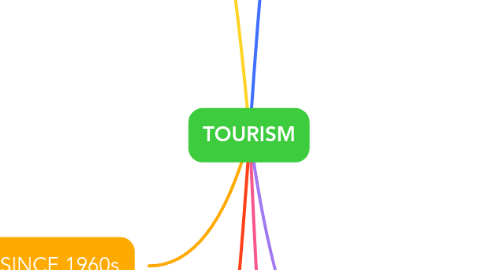
1. TYPES OF TOURISM
1.1. Places with scenic beauty
1.1.1. Honeypot tourism
1.1.1.1. Eg. Victoria Falls, located on the Zambezi River on the boundary of Zimbabwe and Zambia River in Africa
1.2. Places with good facilities
1.2.1. MICE facilities
1.2.1.1. Eg. Singapore was the leading convention city in Asia Pacific in 2017, drawing 2.4 million business travellers which accounted for 14% of all visitors to SG in 2017
1.2.2. Medical tourism
1.2.2.1. Eg. Cosmetic surgery in South Korea as the country is renowned for its highly skilled doctors and advanced technology in cosmetics
1.2.3. Theme parks
1.2.3.1. Eg. Disneyland operating at various locations around by the world by the Walt Disney Company; Walt Disney World in Florida
1.3. Places with rich culture
1.3.1. Heritage tourism
1.3.1.1. Eg. 15 million international tourists are attracted to London, United Kingdom, each year to visit sites such as the London Bridge or Buckingham Palace
1.3.2. Film-induced tourism
1.3.2.1. Eg. Zhangjiajie National Forest Park in China where Avatar was filmed
1.3.3. Pilgrimage tourism
1.3.3.1. Eg. World’s largest pilgrimage, Hajj to Mecca, Saudi Arabia, which attracts over 3 million pilgrims, including 1.8 international pilgrims.
1.4. Places of conflict
1.4.1. Dark tourism
1.4.1.1. Eg. Nanjing Massacre Memorial Hall in Nanjing, China
2. TOURISM TRENDS SINCE 1960s
2.1. Trends in global tourism industry
2.1.1. International tourism: Increasing
2.1.2. Domestic tourism still most popular form of tourism
2.2. Evolution of forms of tourism
2.2.1. Mass to niche
2.2.2. Short haul to long haul
3. REASONS FOR THE GROWTH IN TOURISM
3.1. Developments in technology
3.1.1. Better and affordable transport
3.1.1.1. Commercial air travel: More time efficient today
3.1.1.2. Budget airlines: more affordable
3.1.2. Ease of access to information
3.1.2.1. Online books, articles and websites: Increased accessibility and convenience
3.1.2.2. Surviellence and electronic checks: Increased security
3.2. Demand factors
3.2.1. Increased disposable income
3.2.2. Increased leisure time
3.2.3. Changing lifestyles
3.3. Destination factors
3.3.1. More attractions
3.3.2. Greater investment in infrastructure and services
3.3.3. Easy access to information
4. MANAGING IMPACTS OF TOURISM (through conservation and ecotourism/ sustainable tourism)
4.1. Conserving fragile environments and promoting sustainable tourism
4.1.1. Conserving fragile environments and promoting sustainable tourism
4.2. Managing arising tensions
4.2.1. Between locals and tourists
4.2.1.1. Eg. Bali, Indonesia
4.2.2. Between locals and environment
4.2.2.1. Eg. Machu Picchu, Peru
4.2.3. Solutions
4.2.3.1. Government/ authorities: provide funding, monitoring, or implementing laws or restrictions:
4.3. Responsibility of different stakeholders
4.3.1. Visitors
4.3.1.1. Responsibility to respect both the environment and local population of the place and not cause any damage or offence
4.3.2. Local communities
4.3.2.1. Conserves and protects tourist areas through community-based tourism in partnership with the government/ NGOs
4.3.3. Tour operators
4.3.3.1. Promote eco-tourism through promoting responsible tourism and educating tourists
4.3.4. Non-governmental Organisations (NGOs)
4.3.4.1. Preserve and protect the environment by providing resources and education
4.3.5. Government/ Planning authorities
4.3.5.1. Have the power and capabilities to enforce rules, provide fundings and monitor tourism-related developments in the country
5. IMPACT OF TOURISM
5.1. Economic
5.1.1. Positive
5.1.1.1. Increased employment opportunities
5.1.1.2. Growth in income
5.1.1.3. Development in infrastructure
5.1.2. Negative
5.1.2.1. Seasonal unemployment
5.1.2.2. Under-utilised facilities at certain times of the year (draining money)
5.1.2.3. Shortage of services
5.2. Socio-cultural
5.2.1. Positive
5.2.1.1. Preservation of local customs and heritage
5.2.2. Negative
5.2.2.1. Dilution of heritage and local customs
5.2.2.2. Increased crime
5.3. Environmental
5.3.1. Positive
5.3.1.1. Conservation of natural environment
5.3.2. Negative
5.3.2.1. Vandalism
5.3.2.2. Litter and pollution
5.3.2.3. Destruction of habitats
5.3.2.4. Increased carbon footprint
5.3.2.5. Increased congestion
6. REASONS FOR TOURISM FLUCTUATIONS
6.1. Disasters
6.1.1. Health and safety risks
6.2. Recessions
6.2.1. Loss of income ---> decrease in disposable income
6.3. Political situations
6.3.1. Safety risks, unfavourable conditions (disrupted services and damaged infrastructure)
6.4. Diseases
6.4.1. Health and safety risks
